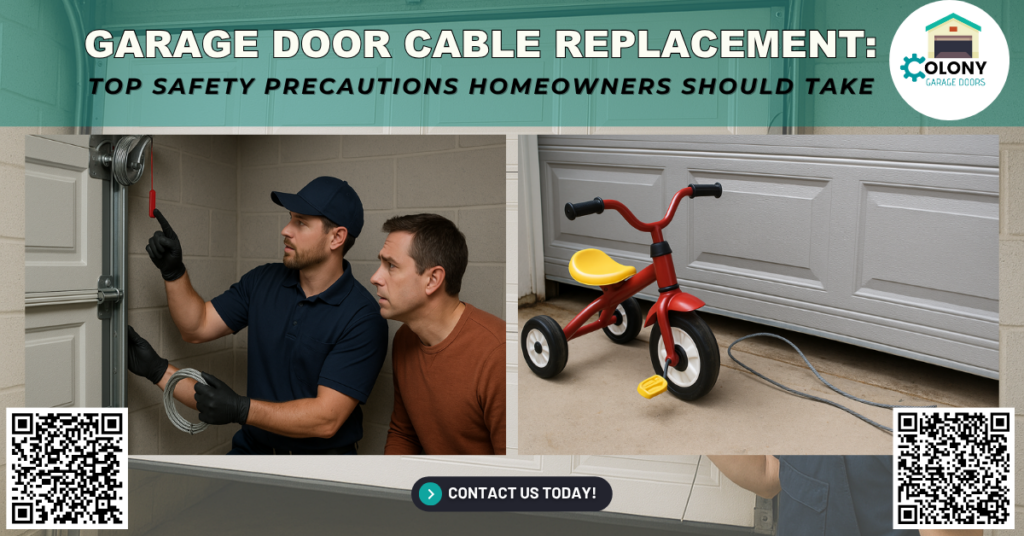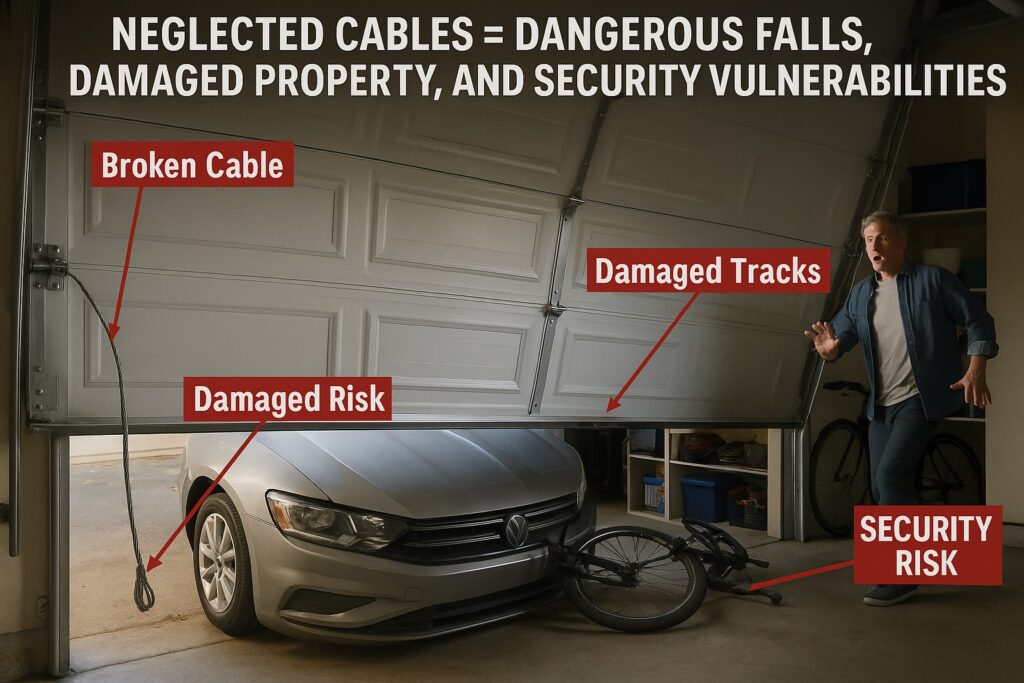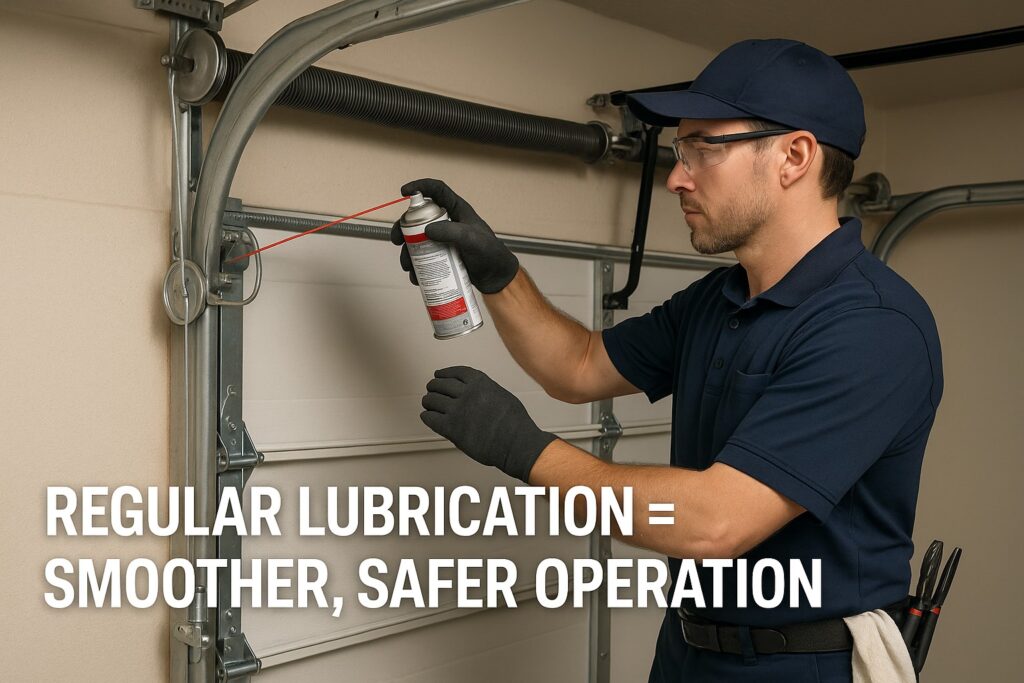Garage Door Cable Replacement: Top Safety Precautions Homeowners Should Take

Why Cable Safety Matters: A Real-World Reminder for Homeowners in Sugar Land, TX
At Colony Garage Doors, we’ve seen firsthand how quickly something as small as a frayed garage door cable can lead to a major home safety issue. One of our customers in Sugar Land, TX, called us in a panic after their garage door came crashing down onto their car. Thankfully, no one was hurt, but the repairs weren’t cheap, to both the garage door system and the damaged vehicle. After inspection, we found the problem was a worn cable that snapped after years of unnoticed wear and tear.
Unfortunately, this kind of situation isn’t unique. The U.S. Consumer Product Safety Commission (CPSC) reports that garage doors cause more than 20,000 injuries annually across the U.S., from pinched fingers to severe accidents caused by falling doors. In many cases, these injuries are entirely preventable with proper maintenance of essential garage door parts like cables, torsion springs, garage door rollers, and garage door openers.
Homeowners often focus on the obvious elements of their garage doors, garage door design, garage door windows, or decorative carriage house-style panels. However, it’s the hidden mechanical components, such as cables, extension springs, and bottom brackets, that play the most critical role in maintaining safe operation. Ignoring these small parts can lead to big problems.
If you’re in Sugar Land or the surrounding areas, this comprehensive guide is designed to help you understand the risks of worn garage door cables, how to spot early signs of wear, and the crucial safety precautions every homeowner should follow.
The Role of Garage Door Cables in Your Garage Door System
Understanding How Cables Work
Your garage door cables work in tandem with garage door springs, either torsion springs mounted above the door or extension springs positioned along the horizontal tracks. These cables help manage the enormous weight of the door, typically ranging between 150-300 pounds for residential doors and even more for commercial doors. The cables wind and unwind smoothly, counterbalancing the weight of the door and ensuring it can be lifted or lowered safely, whether manually or through automatic door openers.
When cables are properly maintained and under the correct tension, your door moves in a controlled, balanced manner. When they’re frayed, corroded, or loose, however, the door becomes unstable. Without the cables functioning correctly, your garage door springs bear uneven loads, leading to premature failure and dangerous situations.
How Cable Issues Affect Other Components
Every component in your garage door system is interconnected. Failing cables strain other parts, like:
- Garage door openers and garage door operators
- Door rollers and garage door hinges
- Brackets, lag bolts, and fasteners
- Tracks and alignment components
- Door weather seals affecting energy efficiency
If cables snap, they can create additional damage by pulling other garage door parts out of alignment or forcing the garage door springs to handle the full weight alone, often causing catastrophic failure.
Types of Garage Door Cables and Their Purpose
There are different types of cables, each serving a unique function:
- Torsion Spring Cables: Thicker and designed to handle heavier loads, these cables work with torsion springs mounted on the header above the garage door.
- Extension Spring Cables: Typically used on lighter doors, these assist extension springs located along the sides of the door.
- Safety Cables: Secondary cables are installed through extension springs to prevent the springs from flying off if they break, offering an extra layer of protection.
The Dangers of Ignoring Cable Maintenance
Real-World Risks for Homeowners
Failure to maintain your garage door cables doesn’t just lead to malfunctions; it can cause serious harm. If a cable snaps while the door is open, the sudden release of tension can cause the door to fall without warning. A 200-pound door falling even a few feet can destroy property, seriously injure people, and even endanger pets.

Beyond personal injury, neglecting cables can result in expensive damage to other garage door parts like the garage door opener, garage door hinges, door panels, and alignment tracks. It may also compromise your home’s security an improperly functioning garage door is an easy target for intruders.
Systemic Failures and Escalating Repair Costs
Ignoring one failing cable doesn’t just cause that part to fail; it creates a domino effect:
- Garage door springs will compensate and weaken faster.
- Garage door operators and automatic openers strain under uneven loads, leading to motor or gear failure.
- Tracks, door rollers, and hinges may become misaligned or bent, complicating the repair and increasing costs.
Proactive cable replacement is always less expensive than reactive system overhauls.
Signs Your Garage Door Cables Need Replacement
Visual and Functional Clues of Cable Failure
Homeowners can often spot early warning signs of failing cables with simple observation during routine use:
- Fraying or Unraveling: Wires splitting apart indicate structural weakness.
- Rust or Corrosion: Common in humid areas like Sugar Land; corrosion weakens metal cables over time.
- Loose or Sagging Cables: Properly functioning cables maintain tension; slack means failure is near.
- Uneven Door Movement: If the door tilts or lifts unevenly, one side’s cable may be compromised.
- Unusual Noises: Grinding or scraping sounds may indicate cables rubbing against other garage door components.
Increased Safety Risks Over Time
Ignoring these signs can lead to:
- Emergency repairs with higher costs.
- Injury from sudden failures.
- Additional replacement of other parts like springs, rollers, or garage door operators.
Scheduling professional garage door maintenance annually helps catch these problems before they escalate.
Why DIY Cable Replacement is Dangerous
Understanding the Risks of High-Tension Systems
Replacing garage door cables isn’t like swapping out a worn garage door weather seal or adjusting a loose hinge. These cables are tightly wound under the extreme tension of torsion springs or extension springs, springs capable of storing enormous kinetic energy. One slip with a wrench or winding bar can result in serious injuries, including lacerations or broken bones.
Professional technicians use specialized tools and follow precise engineering practices during:
- Cable replacements
- Spring adjustments
- Roller alignments
- Operator calibrations
Attempting DIY repairs without the right knowledge and tools risks personal safety and could void warranties on both garage doors and garage door parts.
Professional Safety Procedures for Cable Replacement
Inspection and Diagnosis
Professionals start with a full diagnostic inspection of all related garage door components:
- Garage door springs and cables
- Garage door rollers, hinges, and tracks
- Garage door operator systems and remote controls
- Weather seals and insulation impact energy efficiency
By understanding the complete system, they ensure no underlying issues go unnoticed.
Precision Tools and Techniques
Technicians rely on industry-specific tools:
- Winding bars for safe spring adjustment
- Cable tension gauges for accuracy
- Lubricant grease for smooth operation
- Reinforcement brackets and compliant control accessories
This level of precision, often supported by CNC-fabricated parts and exact fabrication, is essential for longevity and safety.
Post-Replacement Testing for Safety
After installation:
- Garage door balance is tested for smooth, even motion.
- Garage door opener limits and safety sensors are recalibrated.
- Auto-reverse features are confirmed to meet safety standards.
- Final checks ensure compliance with local building codes and industry standards.
Common Mistakes to Avoid as a Homeowner (Expanded)
1. Ignoring Early Warning Signs
Many homeowners notice small issues like slight jerking movements, strange noises, or cables that look a little worn but shrug them off, hoping they’ll go away on their own. This is a costly mistake. Ignoring these early warning signs often leads to bigger problems down the road, such as snapped cables or damaged garage door springs, which can cause your door to become dangerous and more expensive to repair. Acting promptly protects both your home and your wallet.
2. Choosing Cheap Replacement Parts
It’s tempting to save money by choosing the cheapest parts available, especially from big-box retailers or unknown online sellers. However, low-quality garage door parts wear out faster and can fail unexpectedly, putting you at risk. Investing in high-quality, manufacturer-approved components, whether it’s cables, torsion springs, or garage door rollers, helps ensure long-term safety, performance, and durability for your entire garage door system.
3. Hiring Unqualified Technicians
Garage door repairs require specialized knowledge, tools, and experience. Hiring someone without proper training or credentials might seem more affordable upfront, but unskilled labor often leads to mistakes that compromise your door’s safety and function. Always check for certifications, insurance, and positive customer reviews before trusting a technician with your garage door maintenance or repairs.
4. Neglecting Overall Maintenance
Your garage door is a complex system where all parts work together; if one fails, others are often close behind. Neglecting regular maintenance, such as lubricating door rollers, inspecting garage door springs, and checking garage door openers, can shorten the lifespan of your system. Routine professional inspections keep your door operating smoothly, safely, and efficiently while avoiding unexpected breakdowns.
Frequently Asked Questions (FAQs)
1. Can a broken garage door cable cause my opener to stop working?
Yes, a broken cable can prevent the garage door from opening or closing properly, which in turn may cause your garage door opener to strain, malfunction, or shut down entirely as a safety precaution.
2. How long does it take for a professional to replace garage door cables?
Most professional technicians can complete a cable replacement within 1 to 2 hours, depending on the complexity of your garage door system and whether additional garage door parts also need adjustment.
3. Are garage door cables covered under home warranties?
Some home warranties may cover garage door components, but it’s important to check the policy details. Typically, wear-and-tear on cables is considered maintenance and may not be included.
4. Can cold weather cause garage door cables to snap?
Yes, extreme cold temperatures can make metal components brittle, increasing the risk of fraying or snapping, especially if the cables already have signs of wear or rust. Regular inspections before winter can help prevent this.
Preventative Maintenance: Your Best Safety Strategy
Establishing a Maintenance Routine
Proactive maintenance keeps your garage door system running safely and efficiently. An annual inspection checks for:
- Cable fraying or corrosion
- Garage door springs wear and tear
- Garage door opener functionality
- Lubrication of rollers, hinges, and moving parts
- The condition of seal solutions impacting energy efficiency

Benefits of Preventive Maintenance
- Avoid emergency repairs
- Extend the lifespan of your garage door products
- Improve home security
- Maintain warranty coverage
- Enhance the door’s smooth operation and energy efficiency
Final Thoughts
Your garage door is more than just a convenience, it’s an integral part of your home’s security, safety, and curb appeal. Overlooking the health of essential garage door parts like cables, torsion springs, and garage door openers can lead to accidents, expensive repairs, and unnecessary risks. Routine inspections, prompt replacements, and professional maintenance ensure your system operates safely and reliably.
By investing a little time and care into your garage door maintenance, you protect your family, your property, and your wallet from the unexpected. Whether you have a simple residential operator system or a complex commercial door setup, these principles apply.
How Can Colony Garage Doors Help You?
At Colony Garage Doors, we specialize in delivering safe, efficient, and reliable garage door services across Sugar Land and surrounding communities. Our team brings years of experience working with all aspects of garage door systems, from garage door springs to commercial gates and custom fabrication solutions.
Why Choose Us?
✅ Locally Owned and Trusted
✅ Expert Repairs and Installations
✅ Comprehensive Service for Residential & Commercial Doors
✅ High-Quality, Precision Parts and Craftsmanship
✅ Clear, Upfront Pricing with No Hidden Fees
✅ Fully Licensed and Insured for Your Peace of Mind
Whether you need cable replacement, a new garage door, or simply a trustworthy inspection of your system, Colony Garage Doors is here to help with professional care and exceptional service.
📍 Address: Southwest Fwy Unit A, Sugar Land, TX 77479
📞 Phone: (832) 345-9267
Contact us or book online to schedule your inspection or service. At Colony Garage Doors, your safety, convenience, and satisfaction always come first.
